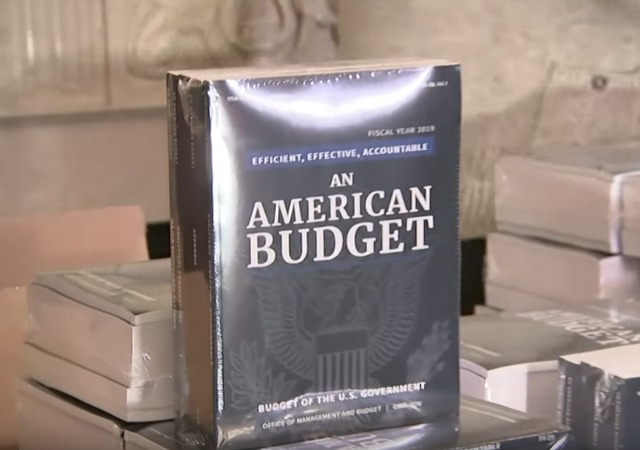Trump Unveils $4 Trillion Budget Concentrating on Infrastructure, Cutting Red Tape

President Donald Trump has rolled out the budget for 2019, written by budget director Mick Mulvaney. While it demands cuts to federal spending, it avoids balancing the budget within 10 years.
Infrastructure received the main point of the budget for $1.5 trillion and cutting red tape. Trump tweeted out that after the country spent $7 trillion in the Middle East, it’s time to start investing in America.
Infrastructure
Fox News reported:
Under the plan, $200 billion of the $1.5 trillion in proposed spending would be federal dollars, which a senior administration official said would come from “reductions in other areas of the budget.” The plan calls on state and local governments and the private sector to put up most of the funding. The federal funding would be used to match local spending, provide “incentives” and expand loan programs.The plan also would boost investment for projects in rural America — including transportation, broadband, water, waste, power, flood management and ports — by $50 billion in a bid to address criticism from some Republican senators that the Trump administration’s initial emphasis on public-private partnerships would do little to help those areas.But the Trump administration is casting another part of the plan as equally vital – streamlining the permitting process, which a senior administration official described as “fundamentally broken.”That component aims to cut the permitting process for new projects from upwards of 10 years to just two years.
In order to do this, the White House wants one federal agency to decide on infrastructure bids “with decision-making consuming about 21 months and permitting consuming the remaining three.” This will “remove ‘duplicative’ elements that currently lead to second-guessing, delays and other problems when multiple agencies weigh in on the same decision.”
From Politico:
“The current system is fundamentally broken, and it’s broken in two different ways,” a senior administration official told reporters during a briefing Saturday. “We are underinvesting in our infrastructure, and we have a permitting process that takes so long that even when funds are adequate, it can take a decade to build critical infrastructure.”Trump’s plan, the official said, offers “a permanent fix.” The plan also includes specific money for rural communities, aim to encourage apprenticeships and other forms of workforce training, and pay for unspecified “transformative,” “next-century-type” projects that would “lift the American spirit,” the official said.
Response From the Parties
Both parties agree our infrastructure needs help, but as usual, they cannot agree on how to go about it to fix it. Democrats have, of course, come out against the plan. Rep. Peter DeFazio (D-OR), the Transportation Committee’s top Democrat, said the budget “is not a real infrastructure plan – it’s simply another scam, an attempt by this administration to privatize critical government functions, and create windfalls for their buddies on Wall Street.”
Ah, yes. The buzzword “Wall Street.” He continues to predict doomsday by insisting that “our potholed roads will get worse, our bridges and transit systems will become more dangerous, and our tolls will become higher.”
Dogs and cats living together. Mass hysteria.
Border Security, Opioids, Veterans
The budget includes $13 billion more for two years towards “opioid prevention, treatment and long-term recovery.” It also has a request for $23 billion for border security, which also includes $18 billion for a border wall.
Trump also requested $85.5 billion for veterans medical care.
Deficit
New spending and the tax reform bill means that the budget “will not wipe out the deficit.” This is the problem I had with the tax reform plan. Yes, in the short run, the tax cuts are great, but no one bothered to cut spending.
The budget cuts $3 trillion over ten years, but it also adds $300 billion. There’s no balancing the budget. How can you spend money when you don’t have it coming in?
Joseph Lawlor at The Washington Examiner wrote (emphasis mine):
Those spending cuts would mean that the federal debt would eventually fall as a percentage of GDP, from around 75 percent of the economy today to 73 percent at the end of the decade. But the budget wouldn’t balance in any of the next 10 years, which means there would be no reduction in the actual amount of debt the government has taken on.That lack deprives Mulvaney of the talking point that he has drafted a plan for balancing the budget — a goal long sought by conservatives, who criticized President Obama each year for proposing budgets that never balance.The difficulty for Mulvaney in balancing the budget is that Trump just signed a tax overhaul that is estimated to lower revenues by around $1.5 trillion over the next 10 years, and a spending deal that will add $320 billion to the deficit in the next two years. Those deficit-widening pieces of legislation cut against the goal of bringing spending and taxes into alignment.
Lawlor points out that the new spending along with the budget will probably lead to Trump NOT cutting “government programs in the years ahead.” Yes the budget cuts 40% on domestic spending, but “Trump just signed legislation increasing spending.” He continued:
The spending deal reached between Senate Majority Leader Mitch McConnell and Democratic Leader Chuck Schumer would pave the way for much higher spending over 10 years, adding around $2 trillion to the debt when interest costs are considered, according to the Committee for a Responsible Federal Budget.In that scenario, the federal debt would rise from 75 percent of gross domestic product today to over 100 percent by the end of the decade. That would rival the debt run-up to pay for World War II.
Blah. Stop spending.
CLICK HERE FOR FULL VERSION OF THIS STORY